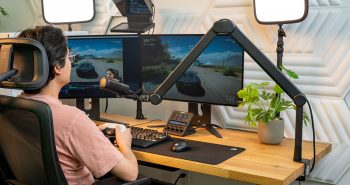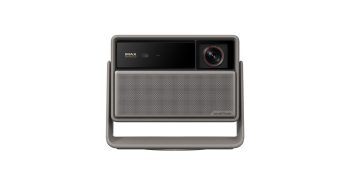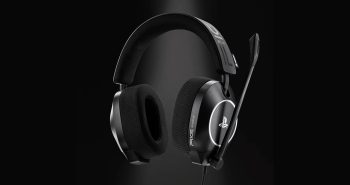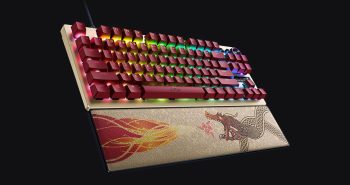Western Digital, one of the grand daddies of hard disk drives, has recently split its internal hard disk drive line into three ‘weight classes’. On the ‘lighter’ end of the spectrum, you will find the ‘Caviar Green’ class, which sports higher energy-savings as well as cooler operating temperatures. In the middle is the ‘Caviar Blue’ class, which is classified as being the ‘everyday computing’ drive. Then there is the ‘Caviar Black’ drive class, which is touted on Western Digital’s official site as having ‘Maximum performance for power computing.’ This last line of hard drives is the one that intrigues us the most, both as gamers as well as geeks. With Western Digital’s ‘VelociRaptor’ line costing upwards of $300 dollars, we are always looking for a better bang for our proverbial buck. So, let’s check out their 1TB Caviar Black drive (model WD1001FALS) and see how it holds up.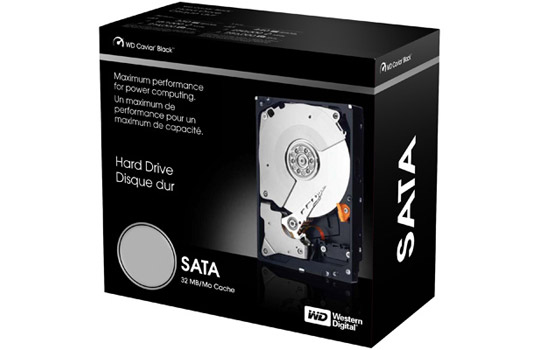
Visually, the drive looks like a fairly standard SATA 3Gb/s, 3.5” hard disk. As with the rest of the Caviar lines, you will not find the VelociRaptor’s heatsink/form factor here, allowing the Caviar Black to fit into any standard 3.5” drive bay with ease. Inside, however, you will find that Western Digital has added a few of the VelociRaptor’s features which help to make the Caviar Black a very reliable drive.
The ‘NoTouch’ ramp load feature prevents the recording head from directly touching the disk platters while the ‘StableTrac’ drive system provides a dually-mounted motor shaft. This helps increase tracking accuracy by decreasing unnecessary vibrations. The third feature taken from the VelociRaptor is the presence of dual processors on the drive which claim to maximize performance. All of these add up to make the Caviar Black one very solid drive. Western Digital seems very confident in this respect as well, given that they grant a five year warranty with the drive. In contrast, the other Caviar lines come with only a three year warranty.
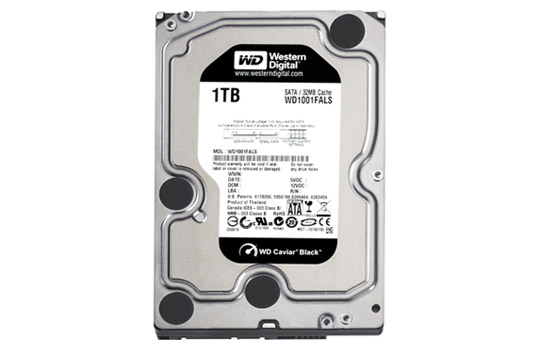
But is it fast? That is the question that preoccupies us this day as what is reliability without speed, especially in a ‘performance’ hard drive? Our test programs consisted of three popular benchmarking choices: HD Tune, HD Tach, and File Copy Test.
Our test rig consisited of…
Intel i7 2.66GHz CPU
6GB DDR3 Memory
Nvidia GTX 280 Video Card
EVGA X58 Mainboard
Here are the results of the drive with HD Tune: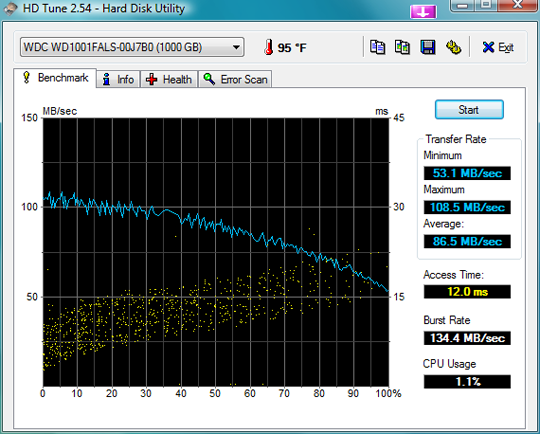
It scored an average read rate of 86.5 MB/sec with a burst rate of 134.4 MB/sec. Access time was rated at 12.0ms, which is in keeping with expectations. However, these results are fairly average for most drives in this class. Let’s take a look at how HD Tach scores the drive.
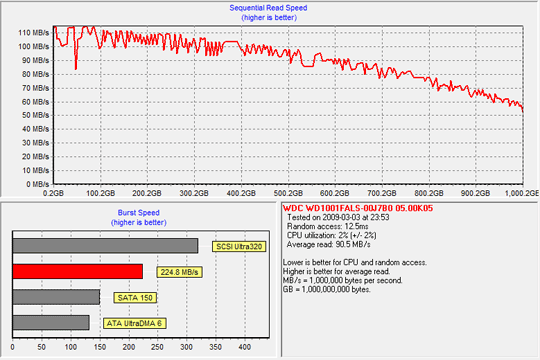
In this test, the Caviar Black scored a 224MB/sec burst rate and 90.5MB/sec average read rate. The drive did take an access hit of 0.5ms in the HD Tach benchmark. However, even with this slight access hit, the transfer rate scores are much more impressive.
Taking the drive into more real-world tests, we ran the popular File Copy Test benchmark application on the Caviar Black. In the program’s ‘Install Create’ test, it finished in 9.141 seconds. This is in contrast to the 18 seconds it took our Hitachi Deskstar 7K1000 drive to do the same. In the ‘ISO Create’ test, the results were echoed with the Caviar Black performing in half the time of the 7K1000. Overall, it appears that in real-world situations, the Caviar Black is one hell of a performer. We believe the secret here is in the Native Command Queuing (NCQ) performance gain of having two processors within the drive. For those who do not know, Native Command Queuing is a way for the drive to access specific places on its platters in the most efficient route possible. If NCQ were not in place, a drive heads would take extra time back-tracking across the platters when they could have already grabed that data on the way to another destination. In short, be thankful NCQ exists!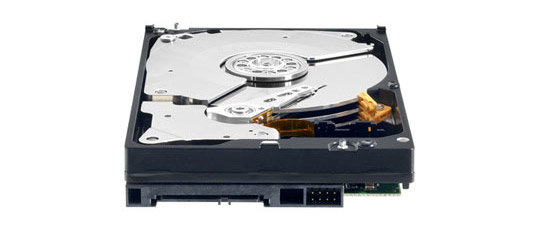
For the green conscious, be aware that the Caviar Black does draw more power from the PSU than, say, the Caviar Green line (which is to be expected). The Caviar Black draws approximately 8.4 watts of power when performing read and write operations while pulling 7.8 watts while idling. In contrast, the Caviar Green line pulls 7.4 watts during read and write operations and only 4 watts while idling. In terms of standby and sleep modes, each drive is about 1 watt, with the Caviar Green taking a slight lead drawing 0.98 watts. This is still better than Segate’s Barracuda 7200.11, which requires 11.6 watts while performing reading and writing operations and a not so eco-friendly 8 watts while simply idling.
The enhanced reliability of Western Digital’s Caviar Black hard drive coupled with its dual-processors for bleeding fast Native Command Queing makes the WDS1001FALS one heck of a performer. Not only will it beat out most non-10k RPM drives in sheer speed, but it will also outlast them thanks to the features borrowed from its big brother, the VelociRaptor. The only potential issue we could find is in the drive’s cost, which at the time of this writing is $149 at the official Western Digital online store. This is $20 to $30 dollars more than most of its 1TB competitors. Still, in this case you are definitely getting what you pay for: Reliability and real-world performance. Think of it as an investment.

